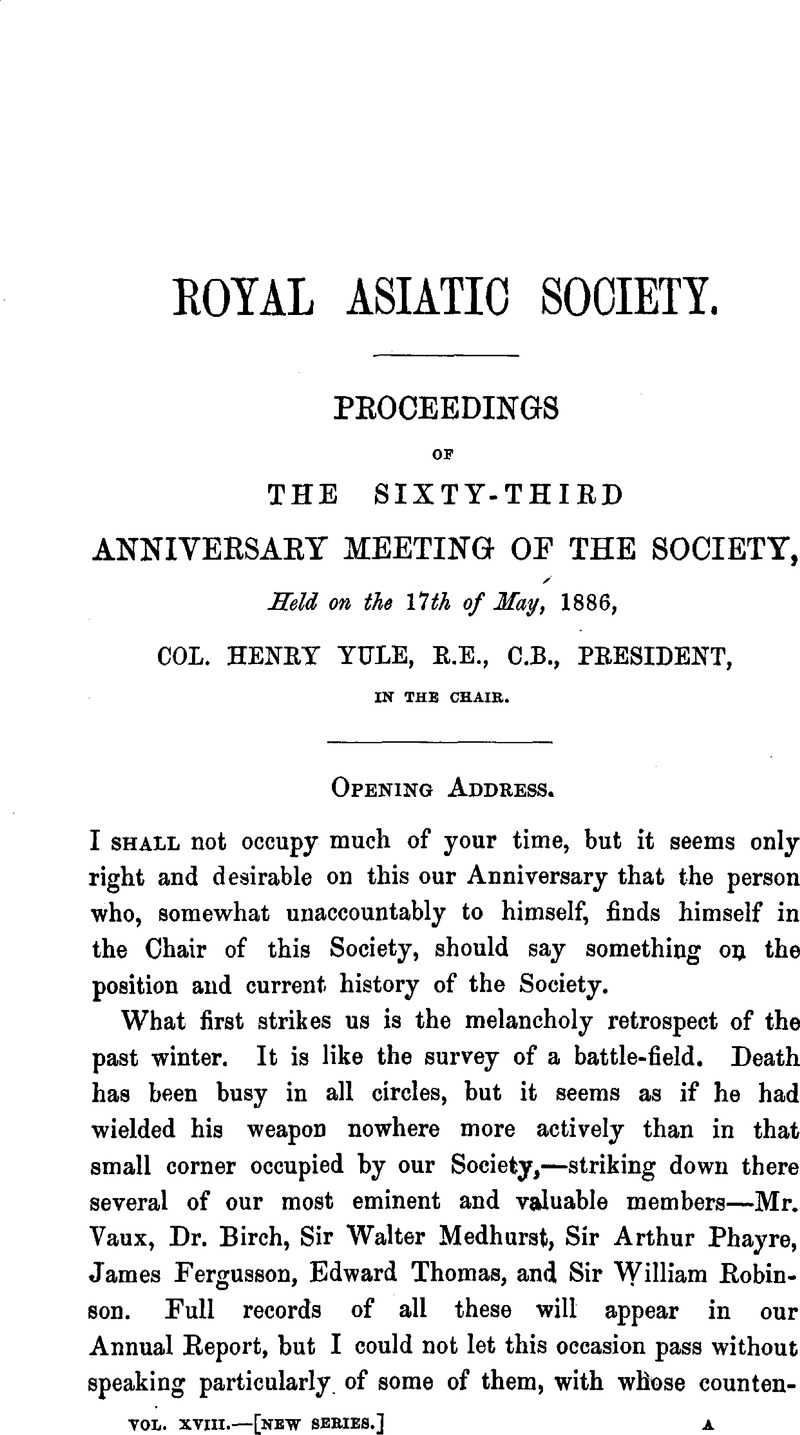No CrossRef data available.
Published online by Cambridge University Press: 15 March 2011

page II note 1 Here follow three or four paragraphs which -will be found in the President's Obituary Notice of Sir Arthur Phayre at page x.
page X note 1 The foundation of this notice is one of greater length compiled by me for the February number of the Proceedings of the Royal Geographical Society. But since then I have been favoured with memoranda by Lieut.-General Sir Richard Meade and by Major-General Barnet ford, of which advantage has been taken.—H. Yule.
page XIV note 1 I see that in the year 1884–85 the number of indigenous schools in the list as inspected was:—Monastic schools, 3837; Lay schools, 879. The schools helped by “grants-in-aid,” were:—Monastic, 825; Lay, 449. Of Monastic schools inspected 21·5 per cent., with 3414 pupils, are stated to have earned grants for results, and 587 pupils, or 17·6 per cent, of the total number, earned result-grants, and 1201 pupils, or 26 per cent, of the number who had earned grants, passed the primary school examinations.
page XVI note 1 A movement is on foot for the erection of a memorial to Sir Arthur Phayre, of which the Secretary in this country is Major-General Barnet Ford, 31, Queensborough Terrace, W. For the same object a meeting was held at Eangoon, on the 6th of March last. It is I presume a sign of the transitory character of society there that the meeting is reported to have been “not very numerously attended.” It was unfortunate that the venerable Roman Catholic Bishop Bigandet, who was one of Phayre's oldest and most valued friends, was unable, probably from his great age, to attend; and that the chief member of the American Mission was also prevented by illness from being present.
page XVI note 2 Obituary notice supplied by Mr. Th. G. Pinches, British Museum.
page XXII note 1 Notice supplied by Sir Thomas Wade, K.C.B., M.R.A.S.
page XXIV note 1 Notice supplied by Mr. William H. White, M.R.A.S., Secretary of the Roy. Instit. British Architects.
page XXIV note 1 See DrFergusson's, Notes and Recollections of a Professional Life; edited by Fergusson, James. London, 1846, 8vo.Google Scholar
page XXXIX note 1 The greater part of this memoir, and list of writings which accompanies it (by Mr. Stanley Lane Poole, M.R.A.S.), have already appeared in the Athenæum.
page XLIII note 1 This memoir is supplied by a friend and brother civilian.
page XLIV note 7 The following incident will show the energy Mr. Robinson brought to bear upon his work in India from his first arrival in the country. Very shortly after he joined his first appointment as assistant to the Collector of Canara, the civil engineer in his circuit visited Mangalore, when an improvement of its harbour was suggested; but nothing could be done because there was no one of the Public Works Department available to make the necessary surveys. Before the engineer's next visit, however, the young Assistant-Collector had taught himself surveying, and prepared a map of the harbour with its soundings ready for his use.
page XLIX note 1 Abridged from an original memoir kindly supplied by F. D. Mocatta, Esq., M.R.A.S.
page LXVI note 1 Of Huber's melancholy fate the following particulars recall the tragedy of the three Englishmen enacted only two years before, beside the Egyptian frontier, some five hundred miles nearer Europe:—
On the night of the 26th July, 1884, he quitted Jedda to return to Haib, his head-quarters, where he had left the greater part of his luggage and collections. His intention was to explore Sadous, a distance of eight days' march to the S.S.E. of Haib, having learnt that some important ruins and inscriptions were to be seen there. Two days later he fell assassinated at Kassai Alia, almost at the very gates of Jedda. He had been accompanied from that town by his servant, Mahmúd, and two guides. Mahmúd had followed the road in charge of the baggage, while Huber and the guides had separated themselves to the right and left, in search of monuments and inscriptions. It had been agreed that all were to meet again at a certain halting-place, at which they were to take rest and refreshment. On the 29th, when Mahmud reached the appointed rendezvous, he saw Huber lying on the ground covered up in his Arab cloak, apparently asleep, and a little way off his guides engaged in prayer. He was about to unload the camels when he felt the muzzles of two barrels placed upon his breast, and heard one of the guides say, “Throw away your arms, or we shall treat you as we did your master.” Mahmúd then observed for the first time that Huber was lying on the left side, and that the right side of his head was covered with blood, but that the body was in repose. He had been killed in his sleep by a pistol shot. Mahmúd, after being kept prisoner for two days, managed to escape the assassins, and relate the story of his master's death to the French vice-consulate. Huber's body lay for two days exposed in the open air, but was at length buried by passers-by, who dug a ditch for the purpose.
page LXXI note 1 Alluded to in Annual Heport for last year, page lxiii, as also the discovery of Râmagrama and the statue at Kasia.
page CXVV note 1 Messrs. Trübner and Co. are the agents for its sale in this country.
page CXXXVII note 7 See note at page LXVI.